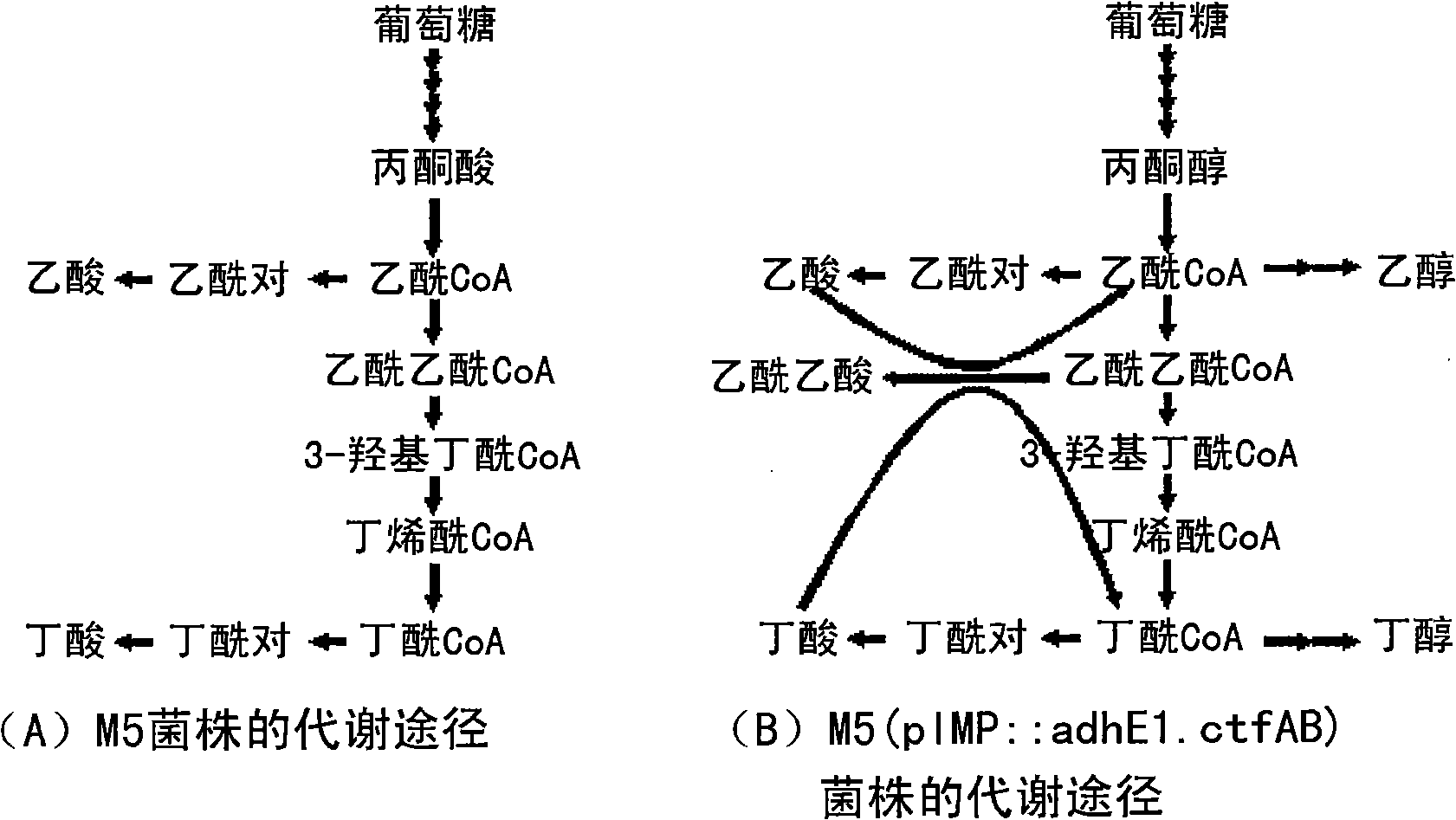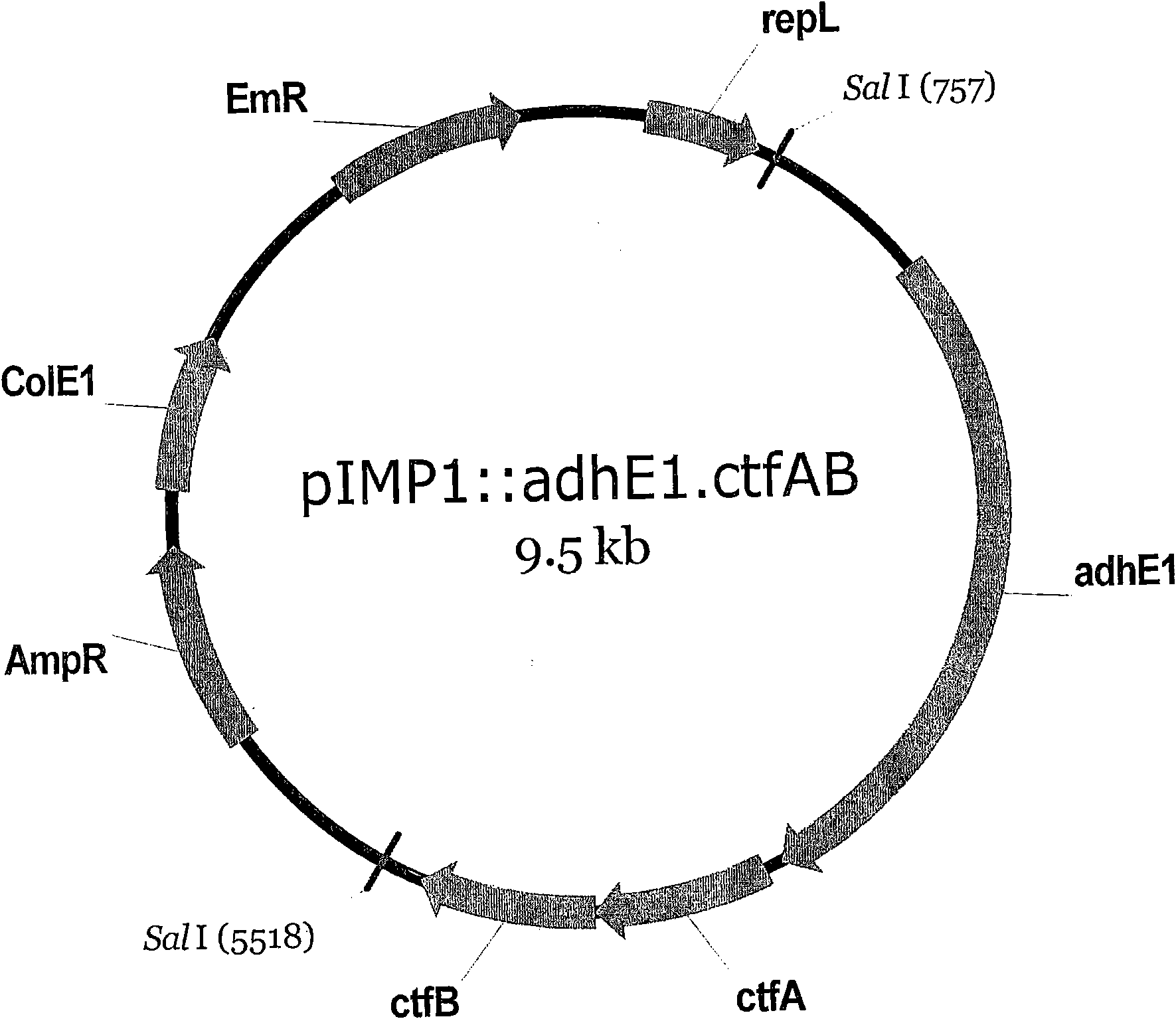Enhanced ethanol and butanol producing microorganisms and method for preparing ethanol and butanol using the same
A technology of microorganisms and recombinant microorganisms, applied in the direction of biofuels, transferases, fermentation, etc., can solve the problems of lack, impossible industrial application, and inability to be used as fuels
- Summary
- Abstract
- Description
- Claims
- Application Information
AI Technical Summary
Problems solved by technology
Method used
Image
Examples
Embodiment 1
[0032] Example 1: Preparation of recombinant vector containing adhE1 gene encoding ethanol / acetaldehyde dehydrogenase and ctfAB gene encoding CoA transferase
[0033] The adhE1, ctfA, and ctfB genes of Bacillus acetobutylicum ATCC 824 with sequence number: 3, sequence number: 4, and sequence number: 5, respectively, were cloned together using a promoter and its transcription termination sequence. First, the chromosomal DNA of Bacillus acetobutylicum ATCC 824 was used as a template, and sequence 1 and sequence 2 were used as primers for PCR (Table 1), and then the obtained adhE1, ctfA and ctfB were cut with restriction enzyme SalI and inserted into the same restriction enzyme The cut Clostridium / E. coli shuttle vector pIMP1 (Mermelstein, LD et al., Bio / Technol., 10:190, 1992) was used to prepare the recombinant vector pIMP1::adhE1.ctfAB (Table 2). The genes encoding ethanol / acetaldehyde dehydrogenase and CoA transferase from Bacillus acetobutylicum ATCC 824 (adhE1, ctfAB) were thu...
Embodiment 2
[0037] Example 2: Construction of recombinant microorganisms
[0038] The M5 (pIMP1::adhE1.ctfAB) strain was constructed by introducing the recombinant vector pIMP1::adhE1.ctfAB constructed in Example 1 into the M5 strain of Bacillus acetobutylicum by electrotransformation. First, the recombinant vector of Example 1 was introduced into the vector pAN1 containing the expression Bacillus subtilis Phage Φ3T I methyltransferase (Mermelstein et al., Appl. Environ. Microbiol., 59: 1077, 1993). Escherichia coli TOP10 to induce its methylation, making the vector suitable for transformation into Clostridium. The methylated vector was isolated and purified from E. coli, and then introduced into a plasmid lacking a giant (carrying 176 genes, including genes encoding acetoacetate decarboxylase, genes encoding CoA transferase, and ethanol / acetaldehyde dehydrogenase Gene) in the mutant strain of Bacillus acetobutylicum M5 (Cornillot et al., J. Bacteriol., 179:5442, 1997), thereby preparing a ...
Embodiment 3
[0042] Example 3: Production of ethanol / butanol using recombinant microorganism M5 (pIMP1::adhE1.ctfAB)
[0043] The recombinant microorganism M5 (pIMP1::adhE1.ctfAB) prepared in Example 2 was cultured in order to check its performance. Sterilize a 30ml test tube containing 10ml of CGM culture medium, take it out at a temperature exceeding 80°C, fill it with nitrogen, and cool to room temperature in an anaerobic chamber. Then, 40 μg / ml erythromycin was added to the medium, and the recombinant microorganisms were inoculated, and then pre-cultured at 37°C under anaerobic conditions to an absorbance value of 1.0 at 600 nm. Sterilize a 250ml flask containing 100ml of the medium with the components, inoculate the medium with 6ml of the pre-culture solution, and conduct a second pre-culture at 37°C under anaerobic conditions until the absorption value at 600nm 1.0. Then, a 5.0L fermentor (LiFlus GX, Biotron Inc., Kyunggi-Do, Korea) containing 2.0L of medium with the components was st...
PUM
 Login to View More
Login to View More Abstract
Description
Claims
Application Information
 Login to View More
Login to View More - R&D
- Intellectual Property
- Life Sciences
- Materials
- Tech Scout
- Unparalleled Data Quality
- Higher Quality Content
- 60% Fewer Hallucinations
Browse by: Latest US Patents, China's latest patents, Technical Efficacy Thesaurus, Application Domain, Technology Topic, Popular Technical Reports.
© 2025 PatSnap. All rights reserved.Legal|Privacy policy|Modern Slavery Act Transparency Statement|Sitemap|About US| Contact US: help@patsnap.com



